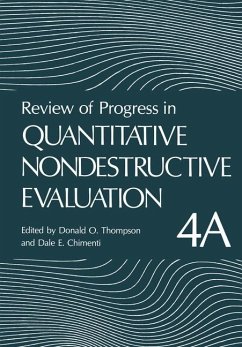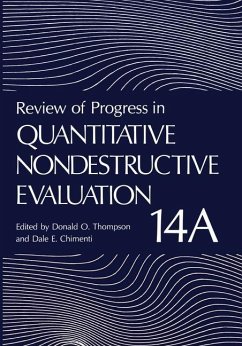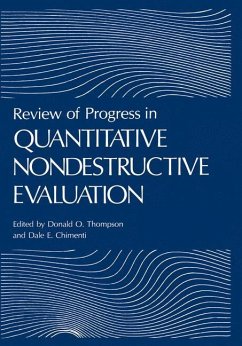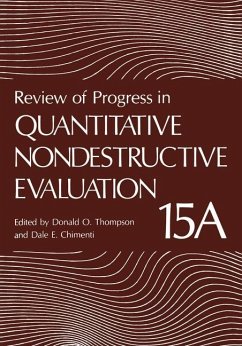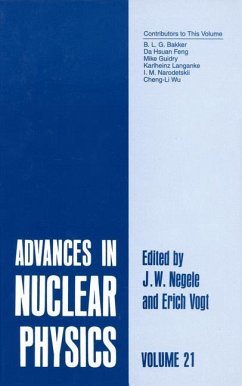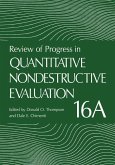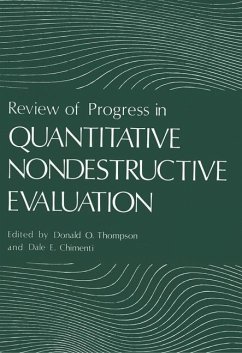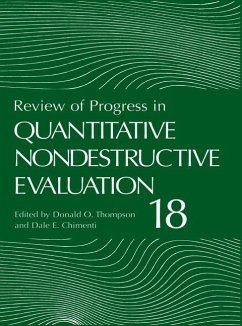Review of Progress in Quantitative Nondestructive Evaluation
Volume 4A
Herausgegeben:Thompson, Donald
Review of Progress in Quantitative Nondestructive Evaluation
Volume 4A
Herausgegeben:Thompson, Donald
- Broschiertes Buch
- Merkliste
- Auf die Merkliste
- Bewerten Bewerten
- Teilen
- Produkt teilen
- Produkterinnerung
- Produkterinnerung
This volume (parts A and B) contains the edited papers presented at the annual Review of Progress in Quantitative NDE held at the University of California, San Diego, July 8-13, 1984. We have chosen to organize the papers by subject, an arrangement that we feel to be more useful for a reference volume than the order of paper presentation at the Review. To do this, topical subject headings have been selected under which the large majority of papers reasonably fall. These categories cover a broad spectrum of research in NDE and encompass activities from funda mental work to early engineering…mehr
Andere Kunden interessierten sich auch für
![Review of Progress in Quantitative Nondestructive Evaluation Review of Progress in Quantitative Nondestructive Evaluation]() Review of Progress in Quantitative Nondestructive Evaluation243,99 €
Review of Progress in Quantitative Nondestructive Evaluation243,99 €![Review of Progress in Quantitative Nondestructive Evaluation Review of Progress in Quantitative Nondestructive Evaluation]() Review of Progress in Quantitative Nondestructive Evaluation42,99 €
Review of Progress in Quantitative Nondestructive Evaluation42,99 €![Review of Progress in Quantitative Nondestructive Evaluation Review of Progress in Quantitative Nondestructive Evaluation]() Review of Progress in Quantitative Nondestructive Evaluation82,99 €
Review of Progress in Quantitative Nondestructive Evaluation82,99 €![Review of Progress in Quantitative Nondestructive Evaluation Review of Progress in Quantitative Nondestructive Evaluation]() Review of Progress in Quantitative Nondestructive Evaluation41,99 €
Review of Progress in Quantitative Nondestructive Evaluation41,99 €![Review of Progress in Quantitative Nondestructive Evaluation Review of Progress in Quantitative Nondestructive Evaluation]() Review of Progress in Quantitative Nondestructive Evaluation404,99 €
Review of Progress in Quantitative Nondestructive Evaluation404,99 €![Review of Progress in Quantitative Nondestructive Evaluation Review of Progress in Quantitative Nondestructive Evaluation]() Review of Progress in Quantitative Nondestructive Evaluation82,99 €
Review of Progress in Quantitative Nondestructive Evaluation82,99 €![Review of Progress in Quantitative Nondestructive Evaluation Review of Progress in Quantitative Nondestructive Evaluation]() Review of Progress in Quantitative Nondestructive Evaluation243,99 €
Review of Progress in Quantitative Nondestructive Evaluation243,99 €-
-
-
This volume (parts A and B) contains the edited papers presented at the annual Review of Progress in Quantitative NDE held at the University of California, San Diego, July 8-13, 1984. We have chosen to organize the papers by subject, an arrangement that we feel to be more useful for a reference volume than the order of paper presentation at the Review. To do this, topical subject headings have been selected under which the large majority of papers reasonably fall. These categories cover a broad spectrum of research in NDE and encompass activities from funda mental work to early engineering applications. The scope and depth of the Review may be easily assessed by examination of the Table of Contents. The Review was sponsored by the Center for Advanced NDE at the Ames Lab oratory of the U.S. Dept. of Energy in cooperation with the Office of Basic Energy Sciences, USDOE, the Materials Laboratory at Wright-Patterson AFB, and the Naval Sea Systems Command. Approximately 300 attendees re presenting various government agencies, industry, and universities parti cipated in the technical presentations, poster sessions, and discussions. This Review, possibly the most comprehensive annual symposium in NDE, provides a valuable forum for the timely exchange of technical informa tion. A few highlights of the Review are summarized in the following paragraphs.
Hinweis: Dieser Artikel kann nur an eine deutsche Lieferadresse ausgeliefert werden.
Hinweis: Dieser Artikel kann nur an eine deutsche Lieferadresse ausgeliefert werden.
Produktdetails
- Produktdetails
- Review of Progress in Quantitative Nondestructive Evaluation 4A
- Verlag: Springer / Springer US / Springer, Berlin
- Artikelnr. des Verlages: 978-1-4615-9423-9
- Softcover reprint of the original 1st ed. 1985
- Seitenzahl: 664
- Erscheinungstermin: 30. Januar 2012
- Englisch
- Abmessung: 244mm x 170mm x 36mm
- Gewicht: 1126g
- ISBN-13: 9781461594239
- ISBN-10: 1461594235
- Artikelnr.: 39620248
- Herstellerkennzeichnung Die Herstellerinformationen sind derzeit nicht verfügbar.
- Review of Progress in Quantitative Nondestructive Evaluation 4A
- Verlag: Springer / Springer US / Springer, Berlin
- Artikelnr. des Verlages: 978-1-4615-9423-9
- Softcover reprint of the original 1st ed. 1985
- Seitenzahl: 664
- Erscheinungstermin: 30. Januar 2012
- Englisch
- Abmessung: 244mm x 170mm x 36mm
- Gewicht: 1126g
- ISBN-13: 9781461594239
- ISBN-10: 1461594235
- Artikelnr.: 39620248
- Herstellerkennzeichnung Die Herstellerinformationen sind derzeit nicht verfügbar.
Keynote Address.- Magnetic Resonance Imaging in Medicine: Quantitative Tissue Characterization.- 1: Ultrasonics.- Section A: Probability of Detection.- Improvements in Ultrasonic Measurement Modeling with Applications to Ultrasonic Reliability.- Statistical Approach to the Automation of Flaw Detection.- Statistical Flaw Detection in a Scanning Mode.- Section B: Scattering.- A Finite Element Formulation for Ultrasonic NDT Modeling.- Comparison of the T-Matrix and Helmholtz Integral Equation Methods for Wave Scattering Calculations.- Ultrasonic Scattering in Composites Using Spatial Fourier Transform Techniques.- Interaction of Ultrasonic Waves with Simulated and Real Fatigue Cracks.- Modeling of Real UT Transducer Field/Flaw Interactions.- Reflection of Ultrasonic Waves by an Array of Microcracks.- A Model for the Ultrasonic Scattering From Multi-Branched Cracks.- The Use of Surface Acoustic Waves to Study Small Fatigue Cracks in 7075-T651 Aluminum and 4340 Steel.- Elastic Wave Scattering by a Surface-Breaking Planar Crack in 3d.- Elastodynamic Stress Intensity Factors for an Interface Crack in a Layered Half Space.- The Elastic Compliance of Imperfect Interfaces: Review and Relationship to Ultrasonic Scattering.- Characterization of a Periodic Surface Profile by Pole-Zero Parameterization of Elastodynamic Pulse Reflections.- Response of an Elastic Plate to Surface Loads and Buried Dislocation Sources.- Surface Wave Modes on Spherical Cavities Excited by Incident Ultrasound.- Section C: Transducers and Signal Processing.- Relationship of Gaussian Beam Theory to Scanned Ultrasonic Measurements with Commercial Transducers.- Deconvolution by Design - An Approach to the Inverse Problem of Ultrasonic Testing.- System Analysis for Wide Band Ultrasonic Test Set-Ups.- DoubleAmplitude Evaluation in Ultrasonic Testing.- Error Sensitivity of Long and Intermediate Wavelength Flaw Reconstruction.- Ultrasonic Welding Defect Sizing by Advanced Pattern Recognition Techniques.- EMAT/Synthetic Aperture Approach to Thick-Weld Inspection.- Characterization of Noise in Austenitic Stainless Steel.- Analysis of Many-Defect Systems.- Section D: Imaging and Reconstruction.- Transmission Scanning Acoustic Microscopy for Tilted Plate Specimens.- Low-Frequency Acoustic Microscopy.- The Focused-Beam Reflection-Mode Acoustic Microscope at Lawrence Livermore National Laboratory - Development and Present Capability.- Holographic Inspection for Debonds in Sonar Transducer Head Mass/Shroud Subassemblies.- Long and Intermediate Wavelength Flaw Reconstruction.- Reconstruction of Defects by Ultrasonic Testing Using Synthetic Aperture Procedures.- Tomographic Reconstruction of Internal Temperature.- Acoustic Tomographic Reconstruction of Anomalies in Three-Dimensional Bodies.- Use of the Analytic Signal in Ultrasonic Imaging.- 2: Eddy Currents.- Section A: Probability of Detection.- Probability of Detection of Flaws in a Gas Turbine Engine Component Using Electric Current Perturbation.- Assessment of the Effects of Scanning Variations and Eddy Current Probe Type on Crack Detection.- Section B: Modeling.- Developments in Surface Crack Detection by the A. C. Field Technique.- Experimental Verification of Eddy-Current Flaw Theory.- Analysis of Eddy Current Response due to Flaws in Imperfectly Conducting Materials.- Application of a Computer Model to Electric Current Perturbation Probe Design.- Numerical Electromagnetic Modeling for Three-Dimensional Inspection of Ferrous Metals.- Section C: Probes and Instruments.- Recent Developments in Eddy Current Testing.- MagneticField Mapping with a SQUID Device.- Calibration Methods for Eddy Current Measurement Systems.- Frequency Dependence of Electric Current Perturbation Probe Response.- Development of a Rotating Ferromagnetic Resonance Eddy Current Probe for Inspecting Small Radius Curved Surfaces on Gas Turbine Engine Components.- Evaluation of an Eddy-Current Tape-Head Probe.- Analysis of Flat Coils' System with Displaced Sensors for Eddy Current NDE of Ferromagnetic Metals.- An Eddy Current Analysis System for Nuclear Fan Cooler Inspection Data Analysis and Interpretation.- Automatic Eddy Current Inspection of Antirotation Windows in F100 Engine Compressor Air Seals.- Automatic Eddy Current Hole Centering for Aircraft Engine Components.- Flaw Detection in Aluminum Welds by the Electric Current Perturbation Method.- Precision Measurement of Eddy Current Coil Parameters.- Section D: Display Methods.- Diffusion, Waves, Phase and Eddy Current Imaging.- Inversion of Eddy Current Data Using Holographic Principles.- Eddy Current Curvilinear Scanned Linear Array Near Real-Time Imaging Technique.- 3: Theoretical and Applied Inverse Methods.- Section A: Theory.- Exact Solution of Probabilistic Inverse Problem Pertaining to the Scattering of Elastic Waves From General Inhomogeneities.- Connection Between Time- and Frequency-Domain Three Dimensional Inverse Problems for the Schrodinger Equation.- An Efficient Numerical Method for Determination of Shapes, Sizes, and Orientation of Flaws for Nondestructive Evaluation.- The Effects of Noise and Bandlimiting on a One Dimensional Time Dependent Inverse Scattering Technique.- Section B: Ultrasonic Applications.- Detection and Characterization of Surface Cracks Using Leaky Rayleigh Waves.- Surface Flaw Characterization Using Ultrasonic BackscatteredSatellite Pulse Technique.- Signal Processing for Underclad Crack Sizing.- Identifying Spherical Voids and Inclusions by Matching the Power Spectra.- Resonant Scattering and Crack Sizing.- Status of Implementation of the Inverse Born Sizing Algorithm.- Section C: Eddy-Current Applications.- Improved Probe-Flaw Interaction Modeling, Inversion Processing, and Surface Roughness Clutter.- An Eddy-Current Model and Inversion Alogrithms for Three Dimensional Flaw Reconstruction.
Keynote Address.- Magnetic Resonance Imaging in Medicine: Quantitative Tissue Characterization.- 1: Ultrasonics.- Section A: Probability of Detection.- Improvements in Ultrasonic Measurement Modeling with Applications to Ultrasonic Reliability.- Statistical Approach to the Automation of Flaw Detection.- Statistical Flaw Detection in a Scanning Mode.- Section B: Scattering.- A Finite Element Formulation for Ultrasonic NDT Modeling.- Comparison of the T-Matrix and Helmholtz Integral Equation Methods for Wave Scattering Calculations.- Ultrasonic Scattering in Composites Using Spatial Fourier Transform Techniques.- Interaction of Ultrasonic Waves with Simulated and Real Fatigue Cracks.- Modeling of Real UT Transducer Field/Flaw Interactions.- Reflection of Ultrasonic Waves by an Array of Microcracks.- A Model for the Ultrasonic Scattering From Multi-Branched Cracks.- The Use of Surface Acoustic Waves to Study Small Fatigue Cracks in 7075-T651 Aluminum and 4340 Steel.- Elastic Wave Scattering by a Surface-Breaking Planar Crack in 3d.- Elastodynamic Stress Intensity Factors for an Interface Crack in a Layered Half Space.- The Elastic Compliance of Imperfect Interfaces: Review and Relationship to Ultrasonic Scattering.- Characterization of a Periodic Surface Profile by Pole-Zero Parameterization of Elastodynamic Pulse Reflections.- Response of an Elastic Plate to Surface Loads and Buried Dislocation Sources.- Surface Wave Modes on Spherical Cavities Excited by Incident Ultrasound.- Section C: Transducers and Signal Processing.- Relationship of Gaussian Beam Theory to Scanned Ultrasonic Measurements with Commercial Transducers.- Deconvolution by Design - An Approach to the Inverse Problem of Ultrasonic Testing.- System Analysis for Wide Band Ultrasonic Test Set-Ups.- DoubleAmplitude Evaluation in Ultrasonic Testing.- Error Sensitivity of Long and Intermediate Wavelength Flaw Reconstruction.- Ultrasonic Welding Defect Sizing by Advanced Pattern Recognition Techniques.- EMAT/Synthetic Aperture Approach to Thick-Weld Inspection.- Characterization of Noise in Austenitic Stainless Steel.- Analysis of Many-Defect Systems.- Section D: Imaging and Reconstruction.- Transmission Scanning Acoustic Microscopy for Tilted Plate Specimens.- Low-Frequency Acoustic Microscopy.- The Focused-Beam Reflection-Mode Acoustic Microscope at Lawrence Livermore National Laboratory - Development and Present Capability.- Holographic Inspection for Debonds in Sonar Transducer Head Mass/Shroud Subassemblies.- Long and Intermediate Wavelength Flaw Reconstruction.- Reconstruction of Defects by Ultrasonic Testing Using Synthetic Aperture Procedures.- Tomographic Reconstruction of Internal Temperature.- Acoustic Tomographic Reconstruction of Anomalies in Three-Dimensional Bodies.- Use of the Analytic Signal in Ultrasonic Imaging.- 2: Eddy Currents.- Section A: Probability of Detection.- Probability of Detection of Flaws in a Gas Turbine Engine Component Using Electric Current Perturbation.- Assessment of the Effects of Scanning Variations and Eddy Current Probe Type on Crack Detection.- Section B: Modeling.- Developments in Surface Crack Detection by the A. C. Field Technique.- Experimental Verification of Eddy-Current Flaw Theory.- Analysis of Eddy Current Response due to Flaws in Imperfectly Conducting Materials.- Application of a Computer Model to Electric Current Perturbation Probe Design.- Numerical Electromagnetic Modeling for Three-Dimensional Inspection of Ferrous Metals.- Section C: Probes and Instruments.- Recent Developments in Eddy Current Testing.- MagneticField Mapping with a SQUID Device.- Calibration Methods for Eddy Current Measurement Systems.- Frequency Dependence of Electric Current Perturbation Probe Response.- Development of a Rotating Ferromagnetic Resonance Eddy Current Probe for Inspecting Small Radius Curved Surfaces on Gas Turbine Engine Components.- Evaluation of an Eddy-Current Tape-Head Probe.- Analysis of Flat Coils' System with Displaced Sensors for Eddy Current NDE of Ferromagnetic Metals.- An Eddy Current Analysis System for Nuclear Fan Cooler Inspection Data Analysis and Interpretation.- Automatic Eddy Current Inspection of Antirotation Windows in F100 Engine Compressor Air Seals.- Automatic Eddy Current Hole Centering for Aircraft Engine Components.- Flaw Detection in Aluminum Welds by the Electric Current Perturbation Method.- Precision Measurement of Eddy Current Coil Parameters.- Section D: Display Methods.- Diffusion, Waves, Phase and Eddy Current Imaging.- Inversion of Eddy Current Data Using Holographic Principles.- Eddy Current Curvilinear Scanned Linear Array Near Real-Time Imaging Technique.- 3: Theoretical and Applied Inverse Methods.- Section A: Theory.- Exact Solution of Probabilistic Inverse Problem Pertaining to the Scattering of Elastic Waves From General Inhomogeneities.- Connection Between Time- and Frequency-Domain Three Dimensional Inverse Problems for the Schrodinger Equation.- An Efficient Numerical Method for Determination of Shapes, Sizes, and Orientation of Flaws for Nondestructive Evaluation.- The Effects of Noise and Bandlimiting on a One Dimensional Time Dependent Inverse Scattering Technique.- Section B: Ultrasonic Applications.- Detection and Characterization of Surface Cracks Using Leaky Rayleigh Waves.- Surface Flaw Characterization Using Ultrasonic BackscatteredSatellite Pulse Technique.- Signal Processing for Underclad Crack Sizing.- Identifying Spherical Voids and Inclusions by Matching the Power Spectra.- Resonant Scattering and Crack Sizing.- Status of Implementation of the Inverse Born Sizing Algorithm.- Section C: Eddy-Current Applications.- Improved Probe-Flaw Interaction Modeling, Inversion Processing, and Surface Roughness Clutter.- An Eddy-Current Model and Inversion Alogrithms for Three Dimensional Flaw Reconstruction.

